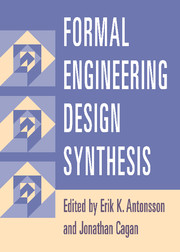Book contents
- Frontmatter
- Contents
- Contributing Authors
- Foreword
- Preface
- Introduction
- 1 Vitruvius Redux
- 2 How to Calculate with Shapes
- 3 Engineering Shape Grammars
- 4 Creating Structural Configurations
- 5 Microsystem Design Synthesis
- 6 Function-Based Synthesis Methods in Engineering Design
- 7 Artificial Intelligence for Design
- 8 Evolutionary and Adaptive Synthesis Methods
- 9 Kinematic Synthesis
- 10 Systematic Chemical Process Synthesis
- 11 Synthesis of Analog and Mixed-Signal Integrated Electronic Circuits
- 12 Mechanical Design Compilers
- 13 Scientific Discovery and Inventive Engineering Design
- Index
5 - Microsystem Design Synthesis
Published online by Cambridge University Press: 10 October 2009
- Frontmatter
- Contents
- Contributing Authors
- Foreword
- Preface
- Introduction
- 1 Vitruvius Redux
- 2 How to Calculate with Shapes
- 3 Engineering Shape Grammars
- 4 Creating Structural Configurations
- 5 Microsystem Design Synthesis
- 6 Function-Based Synthesis Methods in Engineering Design
- 7 Artificial Intelligence for Design
- 8 Evolutionary and Adaptive Synthesis Methods
- 9 Kinematic Synthesis
- 10 Systematic Chemical Process Synthesis
- 11 Synthesis of Analog and Mixed-Signal Integrated Electronic Circuits
- 12 Mechanical Design Compilers
- 13 Scientific Discovery and Inventive Engineering Design
- Index
Summary
It is typical of many kinds of design problems that the inner system consists of components whose fundamental laws of behavior are well known. The difficulty of the design problem often resides in predicting how an assemblage of such components will behave.
– H.A. Simon, The Sciences of the Artificial (1969)INTRODUCTION
Electromechanical devices and systems, constructed at length scales of micrometers to millimeters and fabricated with patterned deposition and removal processes borrowed from microelectronics, were first seriously proposed in Petersen (1982). These devices, now called microelectromechanical systems (MEMS) or microsystems, have been the object of intense research and development since that time, and significant advances in the fabrication and understanding of these devices and systems have been made. A wide variety of devices and systems have been built with a length scale of tens of micrometers (Fan, Tai, and Muller, 1998; Bryzek, Petersen, and McCulley, 1994; Gabriel, 1995; Trimmer, 1997), including
sliders and revolute joints (Fan et al., 1988),
gears (Mehregany et al., 1987; Dopper et al., 1997),
hinges (Pister et al., 1992),
electrostatic actuators (Tang, Nguyen, and Howe, 1989; Tang et al., 1990; Horsley et al., 1999),
motors (Trimmer and Gabriel, 1987; Tai and Muller, 1989; Suzuki and Tangigawa, 1991),
valves (Huff et al., 1990; Jerman, 1990; Emmer et al., 1992; Bosch et al., 1993;
Robertson and Wise, 1998; Chakraborty et al., 2000; Hamn et al., 2000; Papavasiliou, Liepmann, and Pisano, 2000; Rich and Wise, 2000),
capacitive sensors (Schmidt et al., 1987),
accelerometers (Roylance and Angell, 1979; Angell, Terry, and Barth, 1983; Starr, 1990; Ciarlo, 1992; Yee et al., 2000),
[…]
- Type
- Chapter
- Information
- Formal Engineering Design Synthesis , pp. 126 - 169Publisher: Cambridge University PressPrint publication year: 2001
- 1
- Cited by



